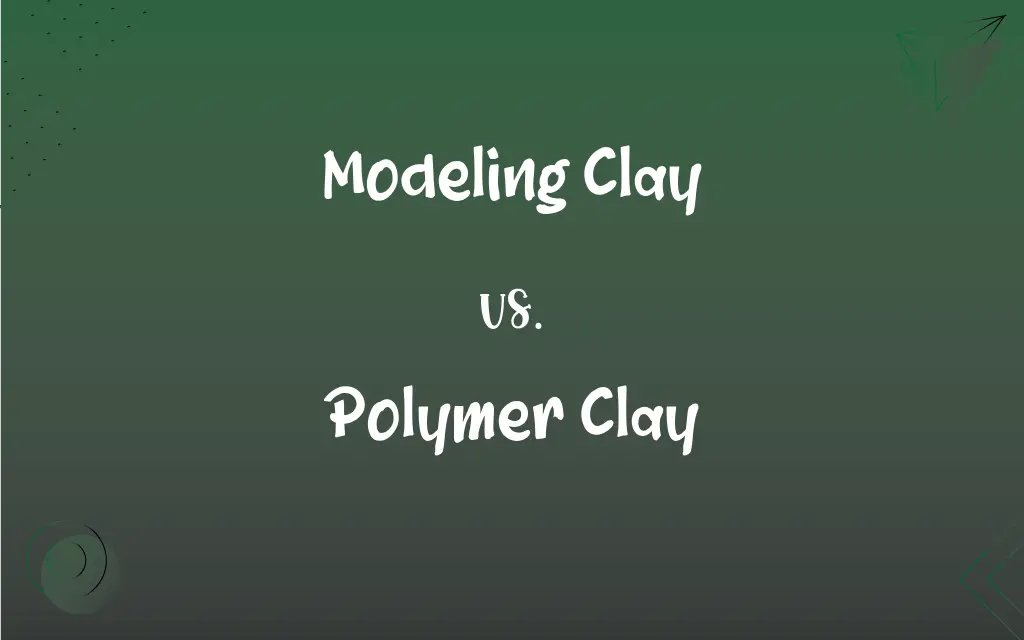Modeling Clay vs. Polymer Clay: What's the Difference?
Edited by Aimie Carlson || By Janet White || Published on December 16, 2023
Modeling clay is a pliable, non-hardening clay used for sculpting; Polymer clay is a sculpting material that hardens when baked.

Key Differences
Modeling clay, often oil-based, remains pliable and does not harden, making it reusable. Whereas, polymer clay, composed of PVC and plasticizers, hardens permanently when baked in an oven.
Modeling clay is ideal for educational and art projects where reusability is key. However, polymer clay is used for creating permanent art objects, jewelry, and decorative items.
The texture of modeling clay is softer and can be less detailed. On the other hand, polymer clay allows for more intricate detailing and finishing.
Modeling clay is not suitable for creating lasting artworks, as it doesn't harden. Polymer clay can be painted, sanded, and varnished after baking.
Modeling clay is generally safer for younger children due to its non-toxicity. Polymer clay requires precautions due to the fumes released during baking.
ADVERTISEMENT
Comparison Chart
Composition
Oil-based, non-hardening
PVC-based, hardens when baked
Use
Reusable for sculpting, educational purposes
Permanent artworks, jewelry, decorative items
Texture and Detail
Softer, less detailed
Allows intricate details
Durability
Does not harden, not durable
Hardens and becomes durable
Safety and Handling
Generally safer for children
Requires precautions for fumes during baking
ADVERTISEMENT
Modeling Clay and Polymer Clay Definitions
Modeling Clay
A sculpting medium that doesn’t dry out or harden.
Modeling clay can be stored and reused multiple times.
Polymer Clay
Requires baking in an oven to harden.
The artist baked the polymer clay creation at a specific temperature to harden it.
Modeling Clay
A non-hardening, pliable material used for sculpting.
Children used modeling clay to create figures in art class.
Polymer Clay
A versatile crafting medium that can be painted and varnished.
After baking, the polymer clay sculpture was painted and varnished.
Modeling Clay
Clay used primarily for educational and practice purposes.
Schools often use modeling clay for teaching basic sculpting techniques.
Polymer Clay
A sculpting material that hardens when baked.
She used polymer clay to make intricate jewelry pieces.
Modeling Clay
A reusable sculpting material.
Modeling clay is perfect for practice before using permanent materials.
Polymer Clay
PVC-based clay used for creating permanent crafts.
Polymer clay is popular for making detailed figurines.
Modeling Clay
Oil-based clay that remains soft and can be reshaped.
The artist used modeling clay to draft his sculpture designs.
Polymer Clay
Used for detailed and fine sculpting work.
Artists use polymer clay for its ability to capture fine details.
FAQs
Does modeling clay harden?
Traditional modeling clay does not harden; it remains pliable and can be reused.
Can modeling clay be baked?
No, baking traditional modeling clay can emit harmful fumes as it is oil-based.
What is modeling clay?
Modeling clay is a malleable material used in sculpting and building models, often used by artists and children.
Is modeling clay toxic?
Most commercial modeling clays are non-toxic, making them safe for children.
What are common uses of modeling clay?
It's used for educational purposes, stop-motion animation, and as a draft for sculptors.
Can you paint modeling clay?
Yes, once a sculpture is complete, it can be painted with various types of paint.
How do you store modeling clay?
It should be stored in an airtight container to prevent drying out.
What is modeling clay made of?
It's typically composed of oil and wax-based compounds, which keep it soft and moldable.
Can polymer clay be painted?
Yes, after baking, it can be painted with acrylic paints.
How is modeling clay different from playdough?
Modeling clay is oil-based and doesn’t dry out, whereas playdough is water-based and can dry and harden.
Is modeling clay reusable?
Yes, it can be reshaped and reused multiple times.
What is polymer clay?
Polymer clay is a type of hardenable modeling clay, made from polymer polyvinyl chloride (PVC).
Is polymer clay toxic?
It’s generally non-toxic, but it should be handled according to safety guidelines, especially when baking.
Can you glaze polymer clay?
Yes, a glaze or varnish can be applied after baking for a glossy finish.
Does polymer clay harden?
Yes, it hardens when baked in a home oven, unlike traditional modeling clay.
What can you make with polymer clay?
It’s used for making jewelry, figurines, home decor items, and miniatures.
Is polymer clay waterproof?
Once baked, it is water-resistant but not entirely waterproof.
How long does polymer clay last?
Unbaked polymer clay can last for years if stored properly in a cool, dark place.
Can you mix polymer clay colors?
Yes, you can mix different colors before baking to create custom shades.
How do you bake polymer clay?
It’s baked at a low temperature, typically around 275°F (135°C), for 15 minutes per 1/4 inch thickness.
About Author
Written by
Janet WhiteJanet White has been an esteemed writer and blogger for Difference Wiki. Holding a Master's degree in Science and Medical Journalism from the prestigious Boston University, she has consistently demonstrated her expertise and passion for her field. When she's not immersed in her work, Janet relishes her time exercising, delving into a good book, and cherishing moments with friends and family.
Edited by
Aimie CarlsonAimie Carlson, holding a master's degree in English literature, is a fervent English language enthusiast. She lends her writing talents to Difference Wiki, a prominent website that specializes in comparisons, offering readers insightful analyses that both captivate and inform.






































































